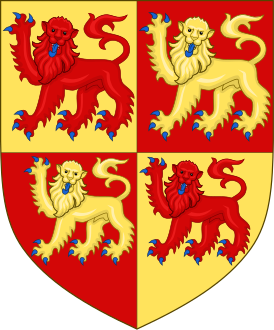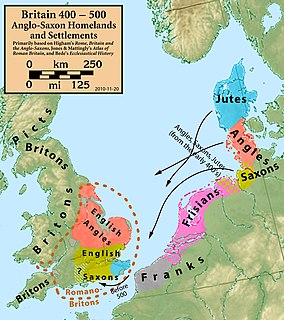The Welsh Marches is an imprecisely defined area along the border between England and Wales in the United Kingdom. The precise meaning of the term has varied at different periods.

Brecknockshire, also known as the County of Brecknock, Breconshire, or the County of Brecon is one of thirteen historic counties of Wales, and a former administrative county. Named after its county town of Brecon, the county is mountainous and primarily rural.

Radnor or Radnorshire is a sparsely populated area, one of thirteen historic and former administrative counties of Wales. It is represented by the Radnorshire area of Powys, which according to the 2011 census, had a population of 25,821. The historic county was bounded to the north by Montgomeryshire and Shropshire, to the east by Herefordshire, to the south by Brecknockshire and to the west by Cardiganshire.

Montgomery is a town and community in the Welsh Marches, administratively in the Welsh county of Powys. It is the traditional county town of the historic county of Montgomeryshire to which it gives its name. The town centre lies about 1 mile (1.6 km) west of the English border. Montgomery Castle was started in 1223 and its parish church in 1227. Other locations in the town include The Old Bell Museum, the Offa's Dyke Path, the Robber's Grave and the town wall. The large Iron Age hill fort of Ffridd Faldwyn is sited northwest of the town and west of the Castle.

The Welsh Dragon appears on the national flag of Wales. The oldest recorded use of the dragon to symbolise Wales is in the Historia Brittonum, written around AD 829, but it is popularly supposed to have been the battle standard of King Arthur and other ancient Celtic leaders. Its association with these leaders along with other evidence from archaeology, literature, and documentary history led many to suppose that it evolved from an earlier Romano-British national symbol. During the reigns of the Tudor monarchs, the red dragon was used as a supporter in the English Crown's coat of arms. The red dragon is often seen as symbolising all things Welsh, and is used by many public and private institutions. These include the Welsh Government, Visit Wales, the dragon's tongue is in use with the Welsh Language Society and numerous local authorities including Blaenau Gwent, Cardiff, Carmarthenshire, Rhondda Cynon Taf, Swansea, and sports bodies, including the Sport Wales National Centre, the Football Association of Wales, Wrexham A.F.C., Newport Gwent Dragons, and London Welsh RFC. The Welsh Dragon is also one of The Queen's Beasts.

A Royal Badge for Wales was approved in May 2008. It is based on the arms borne by the thirteenth-century Welsh prince Llywelyn the Great, with the addition of St Edward's Crown atop a continuous scroll which, together with a wreath consisting of the plant emblems of the four countries of the United Kingdom, surrounds the shield. The motto which appears on the scroll, PLEIDIOL WYF I'M GWLAD, is taken from the National Anthem of Wales and is also found on the Welsh designs for £1 coins minted from 1985 until 2000. The badge formerly appeared on the covers of Assembly Measures; since the 2011 referendum, it now appears on the cover of Acts passed by the National Assembly for Wales and its escutcheon, ribbon and motto are depicted on the Welsh Seal.

Heraldry in Wales has a tradition distinct from that of English and Scottish heraldry. There is evidence that heraldry was already being used in Wales by the middle of the thirteenth century; for instance, in Gwynedd, two sons of Llywelyn the Great are recorded as having borne coats of arms in this period. Following the integration of Wales into England in the fourteenth and fifteenth centuries, the Welsh heraldic tradition became merged into that of England.
Owen de la Pole, also known as Owain ap Gruffydd ap Gwenwynwyn, was the heir presumptive to the Welsh principality of Powys Wenwynwyn until 1283 when it was abolished by the Parliament of Shrewsbury. He became the 1st Lord of Powis after the death of his father Gruffydd ap Gwenwynwyn c. 1287. He is not related to the English de la Pole family descended from William de la Pole, Chief Baron of the Exchequer in the following century, later Earls and Dukes of Suffolk.
Elisedd ap Cyngen ap Cadell
Sir Gruffudd Vychan was a Welsh knight who supported the rebellion of Owain Glyndŵr against the English, captured the Lollard John Oldcastle and was finally executed after the murder of Sir Christopher Talbot.

Attributed arms are Western European coats of arms given retrospectively to persons real or fictitious who died before the start of the age of heraldry in the latter half of the 12th century. Arms were assigned to the knights of the Round Table, and then to biblical figures, to Roman and Greek heroes, and to kings and popes who had not historically borne arms. Each author could attribute different arms for the same person, but the arms for major figures soon became fixed.

The royal standards of England were narrow, tapering swallow-tailed heraldic flags, of considerable length, used mainly for mustering troops in battle, in pageants and at funerals, by the monarchs of England. In high favour during the Tudor period, the Royal English Standard was a flag that was of a separate design and purpose to the Royal Banner. It featured St George's Cross at its head, followed by a number of heraldic devices, a supporter, badges or crests, with a motto—but it did not bear a coat of arms. The Royal Standard changed its composition frequently from reign to reign, but retained the motto Dieu et mon droit, meaning God and my right; which was divided into two bands: Dieu et mon and Droyt.
The House of Mathrafal began as a cadet branch of the House of Dinefwr, taking their name from Mathrafal Castle, their principal seat and effective capital. Although their fortunes rose and fell over the generations, they are primarily remembered as kings of Powys in central Wales.

The Flag of County Durham is the flag of the historic county of Durham. It was registered with the Flag Institute as the flag of the county in 2013, after winning an online competition to decide a flag for the county.

The Coat of arms of the London Borough of Brent is the official arms of the London Borough of Brent. It was granted on 1 September 1965.
















